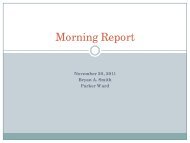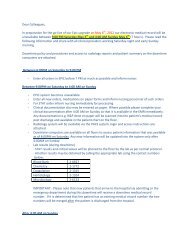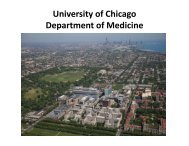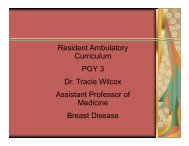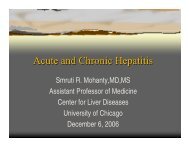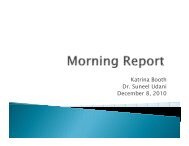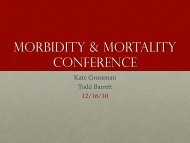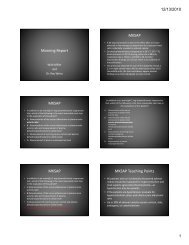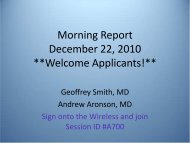Splenic Infarct, Atrial Fibrillation
Splenic Infarct, Atrial Fibrillation
Splenic Infarct, Atrial Fibrillation
Create successful ePaper yourself
Turn your PDF publications into a flip-book with our unique Google optimized e-Paper software.
Morning report<br />
Resident: Bijan<br />
Ghassemieh<br />
Faculty<br />
Discussant: Dr.<br />
Kirk Spencer
45 year-old asymptomatic man, history of sudden<br />
cardiac death in the family: what’s the syndrome?
MKSAP<br />
A 43-year-old man is evaluated during a routine examination. He<br />
has a history of a cardiac murmur diagnosed during childhood.<br />
He exercises regularly without restriction to activity and has no<br />
history of syncope, presyncope, palpitations, or edema. He is on<br />
no medications.<br />
On physical examination, he is afebrile, blood pressure is<br />
120/64 mm Hg, pulse is 80/min and regular, and respiration<br />
rate is 16/min. BMI is 25. He appears well. Cardiac examination<br />
reveals a normal S1 and a physiologically split S2. There is a<br />
grade 2/6 decrescendo diastolic murmur at the left sternal<br />
border. Distal pulses are brisk. There is no pedal edema.
MKSAP<br />
A transthoracic echocardiogram demonstrates normal ventricular<br />
size and function, with ejection fraction of 60% to 65%. There is a<br />
bicuspid aortic valve with moderate regurgitation. The proximal<br />
ascending aorta diameter measures 4.2 cm. Pulmonary pressure<br />
estimates are in the normal range.
MKSAP<br />
Which of the following is the most appropriate management<br />
option for this patient?<br />
A. Antibiotic prophylaxis prior to dental procedures<br />
B. Clinical follow-up in 1 year<br />
C. Surgical referral for aortic valve replacement<br />
D. Transesophageal echocardiography
A.<br />
B.<br />
C.<br />
D.<br />
Please make your selection...<br />
Antibiotic prophylaxis prior<br />
to dental procedures<br />
Clinical follow-up in 1 year<br />
Surgical referral for aortic<br />
valve replacement<br />
Transesophageal<br />
echocardiography<br />
25% 25% 25% 25%<br />
A. B. C. D.
MKSAP<br />
Because a bicuspid valve is subject to higher mechanical and shear stress than<br />
a tricuspid valve, the disease process of progressive calcification is<br />
accelerated, and clinical presentation tends to be earlier—in the fourth or fifth<br />
decades of life. This patient has a bicuspid aortic valve with moderate aortic<br />
regurgitation. Echocardiography demonstrates normal left ventricular size and<br />
systolic function. Pulmonary pressures are in the normal range, and there is no<br />
evidence of adverse hemodynamic effects of valve regurgitation on the<br />
ventricle (ventricular size and function are normal). No specific treatment is<br />
needed at this time. However, because worsening of aortic regurgitation can be<br />
insidious, routine clinical follow-up is indicated in at least yearly intervals,<br />
typically with repeat transthoracic echocardiography to monitor for disease<br />
progression. The presence of a bicuspid aortic valve is associated with<br />
ascending aorta dilation, and TTE can also monitor for aortic enlargement.<br />
Most patients with bicuspid valves will eventually develop significant<br />
abnormalities—aortic stenosis, regurgitation, or aortic root dilation or<br />
dissection—that require surgery.
69 y.o. Male Presents to ED<br />
With FEVER and Abdominal<br />
Pain
HPI<br />
Pain History:<br />
Location: Diffuse throughout abdomen, worse in LUQ<br />
Onset: 2 day ago<br />
Positional: No<br />
Quality: Sharp, constant<br />
Radiation: None<br />
Severity: 7/10<br />
Timing: Constant, not spasmodic<br />
Aggravating: nothing identified (no change with eating)<br />
Alleviating: nothing<br />
GEN: +fevers. No chills, weight loss, sweats<br />
HEENT: ROS negative<br />
CV: No chest pain, palpitations, lightheadedness, orthopnea, PND, LE edema<br />
PULM: No SOB, cough, pleuritic chest pain<br />
GI: + abd px. No nausea, vomiting, diarrhea, constipation, blood in his stool, jaundice,<br />
or pruritis<br />
GU: No frequency, dysuria
PAST MEDICAL/SURGICAL HISTORY<br />
<br />
<br />
<br />
DM<br />
HTN<br />
Complete heart block s/p<br />
MEDICATIONS<br />
<br />
<br />
<br />
HCTZ 25 mg daily<br />
Pantoprazole 40 mg PO daily<br />
Metformin 500 mg PO BID<br />
FAMILY HISTORY: Non-contributory<br />
Medical HIstory<br />
dual chamber pacemaker in 2007<br />
SOCIAL HISTORY: Retired pit-boss. History of moderate alcohol use, quit many<br />
years ago. 25 pack years, quit 5 years ago. No travel or sick contacts.
Physical Exam<br />
Vitals: T 38.3 HR 60 BP 130/67 RR 18 Sat 97% RA<br />
GEN: Appears uncomfortable<br />
HEENT: Sclerae anicteric. Oropharynx clear. No sinus tenderness or nasal<br />
drainage.<br />
CHEST: L chest pacemaker without surrounding erythema, tenderness, or<br />
warmth<br />
CV: RRR. 2/6 holosystolic murmur heard best at LUSB that does not increase<br />
with inspiration (previously documented). No JVD. No LE edema. 2+ radial and<br />
DP pulses bilaterally with good capillary refill<br />
PULM: Breathing unlabored. CTA bilaterally<br />
ABD: Flat abdomen. +BS. Soft. Mild diffuse tenderness, worse in LUQ. Displays<br />
voluntary guarding in the LUQ, no rebound. No masses or organomegally<br />
appreciated.<br />
GU: Normal external genitalia. No inguinal hernia appreciated. No CVA<br />
tenderness<br />
LYMPH NODES: No appreciated cervical, supraclavicular, or inguinal LAD<br />
EXT: No clubbing. No edema. Warm and well perfused. Otherwise unremarkable<br />
NEURO: A+O X3. Strength and sensation grossly intact.<br />
SKIN: No rash
136<br />
4.5<br />
17.0<br />
104<br />
23<br />
12.4<br />
28<br />
1.2<br />
154<br />
Differential: 82% PMNs<br />
What labs/studies would order next?<br />
Initial studies<br />
160<br />
<br />
<br />
<br />
<br />
<br />
UA: unremarkable<br />
LFTs: unremarkable<br />
Lipase: normal<br />
Coags: normal<br />
Blood and urine cxs: Pending
CXR
EKG<br />
Want anything else to workup his belly pain?
CT abdomen<br />
New splenic broad wedge shaped hypodensities concerning for splenic<br />
infarcts.
Uncommon<br />
Clinical manifestations<br />
<br />
<br />
Osler: LUQ pain, tenderness, swelling, and peritoneal friction rub<br />
Retrospective review from Israel identified 26 patients over 12 years and<br />
characterized the clinical findings as……<br />
<br />
<br />
<br />
<br />
<br />
<br />
<br />
L sided abdominal pain in 48% (abd pain absent in 16%)<br />
LUQ tenderness in 36% (abdominal tenderness absent in 32%)<br />
Splenomegally: 32%<br />
Fever in 36%<br />
Nausea/vomiting: 32%<br />
Elevated LDH: 71%<br />
WBC > 12K: 56%<br />
<strong>Splenic</strong> infarction<br />
Why does he have this? What workup would you like?<br />
Lawrence, et all. <strong>Splenic</strong> <strong>Infarct</strong>ion: an update on William<br />
Osler’s observations. Isr Med Assoc J. 2010; 12(6):362
Differential Diagnosis of <strong>Splenic</strong> <strong>Infarct</strong>ion<br />
Hunt DP et al. N Engl J Med 2010;363:1266-1274<br />
Any more studies you<br />
want now?
Clinical course<br />
Patient admitted to the hospital, placed on broad spectrum antibiotics<br />
(cefepime and vancomycin), and pain controlled with IV opiods.<br />
On hospital day 3, his abdominal pain continued and he remained febrile.<br />
Serial blood cultures remained negative. Rheumatologic studies were<br />
unremarkable. CMV and EBV studies still pending. Hypercoaguable studies<br />
were either negative or pending.<br />
Despite negative blood cultures, consideration was given to<br />
echocardiography to evaluate for endocarditis.
Modified Duke Criteria for the Diagnosis of Infective Endocarditis.<br />
Mylonakis E,<br />
Calderwood SB. N<br />
Engl J Med<br />
2001;345:1318-1330.
TEE
TEE Read:<br />
- No evidence of vegetation<br />
-<br />
A left atrial<br />
TEE<br />
appendage thrombus is present.<br />
- No mass or thrombus seen in the right atrium or right atrial<br />
appendage.<br />
There is a catheter in the coronary sinus consistent with<br />
history of bi-ventricular pacer.<br />
Where did this LA clot come from? How do you tie this in with<br />
his abdominal pain?
Patient is started on a heparin ggt.<br />
Patient course (cont)<br />
At this point, the cardiology team is consulted to help determine the<br />
etiology of his LA thrombus.<br />
You are the resident on cardiology. As you are presenting the patient to<br />
your attending on rounds, you pull up the patient’s old EKGs for<br />
comparison
This is what you see . . . . Thoughts?
A-FIB AND CARDIOEMBOLIC RISK
OUR PATIENTS A-FIB WAS A BIT HARDER TO PICK UP<br />
DUE TO HIS COMPLETE HEART BLOCK AND PACER
Explanation of the Threeand Four-Letter Designations for Commonly Used Pacing Modes.<br />
Kusumoto FM, Goldschlager N. N Engl J Med 1996;334:89-99.
OUR PATIENTS RECENT EKGS
1.<br />
2.<br />
3.<br />
A-sensed – sinus<br />
rhythm, V-paced<br />
A-sensed - <strong>Atrial</strong><br />
<strong>Fibrillation</strong>, V-paced<br />
A-paced, V-paced<br />
What is the Rhythm?
OUR PATIENTS RECENT EKGS
1.<br />
2.<br />
3.<br />
A-sensed – sinus<br />
rhythm, V-paced<br />
A-sensed - atrial<br />
fibrillation, V-paced<br />
A-paced, V-paced<br />
What is the Rhythm?
Our patients recent EKgs
1.<br />
2.<br />
3.<br />
A-sensed – sinus<br />
rhythm, V-paced<br />
A-sensed - atrial<br />
fibrillation, V-paced<br />
A-paced, V-paced<br />
What is the Rhythm?
Patient transitioned from heparin to coumadin<br />
Patient’s abdominal pain and fever resolved.<br />
Infectious workup remained negative.<br />
Source of splenic<br />
PATIENT’S COURSE<br />
infarcts presumed to be LA clot.<br />
As you are explaining this to him, he has some questions….<br />
and antibiotics stopped.
Why did the clot go to my spleen and not<br />
somewhere else?<br />
Go, A. S. et al. JAMA 2003;290:2685-2692
Can it still go somewhere else?<br />
Leung, D et all. Thromboembolic Risk of Left <strong>Atrial</strong> Thrombus Detected<br />
by Transesophageal Echocardiogram. American Journal of Cardiology.<br />
79:5(626-629).
WHAT ABOUT THAT NEW BLOOD THINNER<br />
THAT DOESN’T REQUIRE BLOOD DRAWS?<br />
Clatanoff et all. Clinical Experience With<br />
Coumarin Anticoagulants Warfarin and<br />
Warfarin Sodium. Arch Intern Med.<br />
1954;94(2):213-220
Warfarin:<br />
Results in<br />
biologically<br />
inactive forms<br />
of 2, 7, 9, 10<br />
Pathways of Blood Coagulation during Hemostasis and Thrombosis<br />
Furie B, Furie B. N Engl J Med 2008;359:938-949<br />
ATIII, which heparin<br />
activates<br />
Direct 10a inhibitors<br />
Direct<br />
thrombin<br />
inhibitors
RE-LY: Dabigatran vs Warfarin for A-fib: Cumulative Hazard Rates for the Primary Outcome of<br />
Stroke or Systemic Embolism, According to Treatment Group<br />
Connolly SJ et al. N Engl J Med 2009;361:1139-1151
RE-LY: Dabigtran vs Warfarin for A-fib: Safety Outcomes, According to Treatment Group<br />
Connolly SJ et al. N Engl J Med 2009;361:1139-1151
ROCKET : Rivaroxaban vs. Warfarin: Cumulative Rates of the Primary End Point during Treatment and<br />
after Discontinuation in the Intention-to-Treat Population.<br />
Patel MR et al. N Engl J Med 2011;365:883-891
ROCKET: Rivaroxaban vs. Warfarin: Rates of Bleeding Events.<br />
Patel MR et al. N Engl J Med 2011;365:883-891
ARISTOTLE: Apixaban vs. Warfarin for a-fib: Kaplan–Meier Curves for the Primary Efficacy<br />
and Safety Outcomes.<br />
Granger CB et al. N Engl J Med 2011;365:981-992
ARISTOTLE: Apixaban vs. Warfarin for A-fib: Bleeding Outcomes and Net Clinical Outcomes.<br />
Granger CB et al. N Engl J Med 2011;365:981-992
RE-COVER: Dabigatran vs Warfarin for VTE: Cumulative Risk of Recurrent Venous<br />
Thromboembolism or Related Death during 6 Months of Treatment among Patients Randomly<br />
Assigned<br />
Schulman S et al. N Engl J Med 2009;361:2342-2352
RE-COVER: Dabigatran vs. Warfarin for VTE: Cumulative Risks of a First Event of Major<br />
Bleeding and of Any Bleeding among Patients Randomly Assigned<br />
Schulman S et al. N Engl J Med 2009;361:2342-2352
Warfarin vs<br />
Warfarin:<br />
<br />
<br />
Pros<br />
Tried and true (has been used for >50 years) at reducing risk of stroke<br />
Cheap (but hidden cost of INR monitoring)<br />
Reversible (vit K, FFP)<br />
Can use to kill rats<br />
Cons<br />
Slow onset<br />
Frequent INR monitoring<br />
Multiple drug interactions<br />
DTI’s and Apixiban<br />
<br />
<br />
direct thrombin inhibitors and apixiban<br />
Pros<br />
As effective or more effective at preventing clots<br />
Less bleeding complications<br />
No need for monitoring<br />
Faster onset than warfarin<br />
Cons<br />
Can’t reverse (with anything, even FFP); recent article in Circulation suggests rivaroxaban can be reversed with<br />
“prothrombin complex concentrate”<br />
Expensive (but no cost of INR monitoring)<br />
New (post marketing side effects sure to come)<br />
Utility in rat killing unproven
SUMMARY<br />
DIFFERENTIAL AND WORKUP FOR SPLENIC INFARCTION<br />
DON’T FORGET TO EVALUATE THE ATRIAL RHYTHM IN A PACED PATIENT<br />
INCLUDE SYSTEMIC EMBOLI IN YOUR DIFFERENTIAL FOR SOMEONE<br />
WITH A HISTORY OF A-FIB<br />
NEW ANTICOAGULANTS FOR CARDIOEMBOLIC PROPHYLAXIS IN A-FIB



